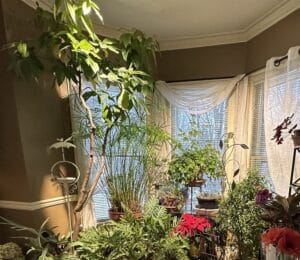Hello, fellow lovers of all things green,
Ruth and Jim, dear friends in Hope, NJ, asked that I water their houseplants while they are away. Their magnificent Money Tree reminds me of one I met a decade ago, along with its plant parent, which turned out to be life-changing.

Ruth and Jim’s Money Tree
I met Diana Sebzda when I learned that the Karen Ann Quinlan Hospice offered not only group sessions for those who have lost a loved one but also one-on-one counseling services on a sliding scale. I was floundering after my brother Bill passed away, combined with other overlapping losses.
Meeting Diana and her Money Tree became life-changing.
It was a gift to benefit from Diana’s wisdom, kindness, and the center’s services. Fast forward three years, and the gift inspired me to become a Hospice Volunteer – it’s hard to believe it’s been over seven years since I’ve had the privilege of being part of the organization. And since meeting Ken Roberts, my singing partner and dear friend.
The Bereavement Center was in Newton, NJ, then. Now, it’s named the Joseph T. Quinlan Bereavement Center in a dedicated building in Augusta. Diana became the Director of Bereavement (I coined her the Queen of Grief), and she and I became friends.
In the entry area of the center was a beautiful plant with beefy glossy leaves and a nifty braided trunk. Money Trees grow into large trees in tropical and subtropical regions but it’s often a bonsai tree as a houseplant. Though Ruth and Jim’s is bountifully growing, reaching the top of a large window in their historic Victorian home…
The Legend of Money Trees
Diana shared the legend that a poor Taiwanese farmer first discovered the unusual yet attractive Money Tree growing in his field. He took it as a sign, dug it up, and brought it home to find it required very little care. The farmer decided to propagate and sell them at the market. They were an enormous success and brought him his longed-for affluence, which is how the Money Tree became associated with wealth and prosperity. But life is much more than about money. Abundance comes from serving others.

Ruth’s nifty watering technique uses a flexible hose attached to a nearby sink.
The number five suggests another theory about the meaning of the Money Tree. They typically have five trunks per plant, five leaves per trunk, and five lobes on each leaf. In Feng Shui, the ancient Asian art of arranging objects to generate a positive outcome, there are five elements: metal, wood, water, fire, and earth. The Money Tree’s pattern of five is said to represent those elements, and placing one in the southeast corner of your home is recommended. A side note: the five trunks are often braided, but they don’t have to be. It’s a way to stabilize the plant.
An “Abundance of Love Tree”
Diana professes not to have a green thumb, and I beg to differ. The mother plant and the offshoot she potted are thriving, which speaks for itself. It also speaks for the nurturing gift she shares with folks like me.

Check out the size of Ruth and Jim’s Avocado tree!
Other common names for the Money Tree are Water Chestnut, Guiana Chestnut, and Malabar Chestnut. I believe only the houseplant or bonsai is called a Money Tree or Money Plant. But I call it an Abundance of Love Tree—the utmost currency.
Jim Ratcliff teaches piano, planting a passion for music that will grow for generations. Ruth is a vibrational sound therapy practitioner offering sound healing to help people achieve overall wellness.
May we all follow whatever path to serve others that makes us feel good, however small. Small gestures of kindness grow as our plants do, spreading ripples of love like a pebble dropped in a pond.
Diana has since retired from her role at the bereavement center, but not from sharing her abundance of love. The seeds continue to grow in all of us whom her service has blessed.
Garden dilemmas? AskMaryStone@gmail.com and your favorite Podcast App.
There’s more to the story in the Garden Dilemmas Podcast (@10 soothing minutes):
Related Stories and Helpful Links:
Houseplants in Duress turn Happy
Benefits of Watering with Rainwater
Sprouting Avocado Seeds in Water
Hospice Butterfly Release featuring a heartfelt reflection by Diana Sebzda
More about Jim and Ruth Ratcliff


